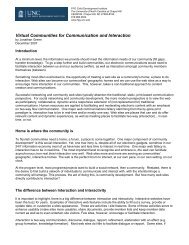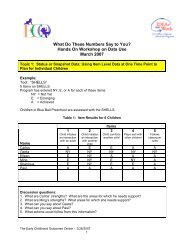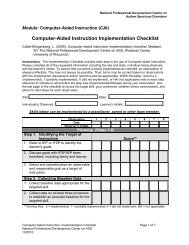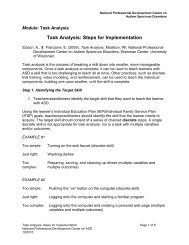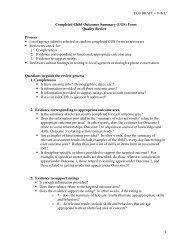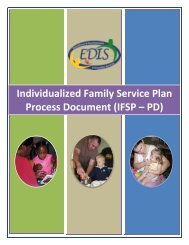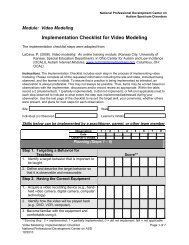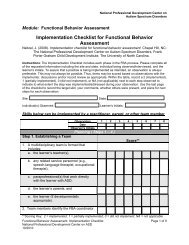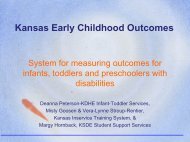(Section 619) Child Example Case Study “Kim” at 35 Months of Age
(Section 619) Child Example Case Study “Kim” at 35 Months of Age
(Section 619) Child Example Case Study “Kim” at 35 Months of Age
Create successful ePaper yourself
Turn your PDF publications into a flip-book with our unique Google optimized e-Paper software.
Preschool (<strong>Section</strong> <strong>619</strong>) <strong>Child</strong><strong>Example</strong> <strong>Case</strong> <strong>Study</strong><strong>“Kim”</strong> <strong>at</strong> <strong>35</strong> <strong>Months</strong> <strong>of</strong> <strong>Age</strong>The N<strong>at</strong>ional Early <strong>Child</strong>hoodTechnical Assistance CenterThis example case study was developed by NECTAC and ECO. This case study andother rel<strong>at</strong>ed documents may be found on the ECO website <strong>at</strong>http://projects.fpg.unc.edu/~eco/pages/training_activities.cfm and on the NECTACwebsite <strong>at</strong> http://www.nectac.org/knowledgep<strong>at</strong>h/ifspoutcomes-iepgoals/ifspoutcomesiepgoals.aspA. Medical and Developmental Background:Kim Doe, who is currently <strong>35</strong> months <strong>of</strong> age, was referred to the <strong>619</strong> program from Early intervention.She had been referred to Early Intervention <strong>at</strong> 17 months, by her pedi<strong>at</strong>rician, Dr. Johnson, due t<strong>of</strong>ailure to thrive associ<strong>at</strong>ed with cardiac anomalies, encephalitis, spasticity (most likely cerebral palsy)and seizures. Dr Johnson’s current health report for Kim provides a diagnosis <strong>of</strong> cerebral palsy, withsignificant spasticity. The history <strong>of</strong> seizure activity has resolved and Kim no longer takes medic<strong>at</strong>ion.Her heart function has stabilized. Kim is still followed by neurology, in addition to her pedi<strong>at</strong>rician, Dr.Johnson.Kim had been hospitalized <strong>of</strong>f and on in Denver, Colorado for the majority <strong>of</strong> her first 14 months <strong>of</strong> lifedue to seizures, numerous viral infections and significant nutritional issues. Kim had an NG tube from 6months <strong>of</strong> age until she was successfully weaned from it by 20 months. Since th<strong>at</strong> time she has beenable to maintain steady, typical weight gain. She has maintained height and weight in the 25- 30 thpercentile for her age. However, she remains a very picky e<strong>at</strong>er, who is orally hypersensitive withfrequent choking or gagging when trying new foods.Mrs. Doe thinks th<strong>at</strong> early intervention has helped Kim make significant gains and supported thefamilies’ capacity to care for her. Mrs. Doe is really interested in getting special educ<strong>at</strong>ion and rel<strong>at</strong>edservices started without delay. Now th<strong>at</strong> Kim is more medically stable, Mrs. Doe is interested inreturning to work, and wants to explore a preschool placement where Kim can receive specialeduc<strong>at</strong>ion services.The most recent report from the early intervention occup<strong>at</strong>ional therapist included home observ<strong>at</strong>ionand discussion with Kim’s Mom:“Kim was able to hold and drink from a spouted cup, but arm movements remain spastic andshe <strong>of</strong>ten splashes and or knocks over the cup when setting it down. She can finger feed avariety <strong>of</strong> small, s<strong>of</strong>t foods, such as cut s<strong>of</strong>t bread sandwiches, s<strong>of</strong>t cooked vegetables, s<strong>of</strong>tfruits, etc. She is beginning to use a spoon more effectively. Although she can chew effectively,she continues to have choking responses to rough, hard or chewy textures (me<strong>at</strong>s, rawvegetables, fruits, etc) Her mother reports she continues to feed baby food to maintain nutrition,while having Kim practice using her spoon to feed herself <strong>at</strong> least half the meal. Mrs. Doe has alist <strong>of</strong> foods she is gradually introducing in small bites to increase Kim’s ability to accept thefoods the family typically e<strong>at</strong>s.Preschool (<strong>Section</strong> <strong>619</strong>) <strong>Child</strong> <strong>Example</strong> <strong>Case</strong> <strong>Study</strong>: <strong>“Kim”</strong> <strong>at</strong> <strong>35</strong> <strong>Months</strong> <strong>of</strong> <strong>Age</strong> 1
Kim was able to assist with dressing (raise an arm, step into a pants leg when held). But due tosignificant challenges in moving her arms and legs she can not yet undress or dressindependently. She can open and close Velcro tabs. Mrs. Doe reports th<strong>at</strong> Kim has strongpreferences and insists on choosing her clothes each day.Kim has functional receptive language skills and routinely follows 2-3 step directions. Sheknows the names <strong>of</strong> her toys, colors, and various household objects. Kim uses 2-3 wordphrases, expresses her wishes and dislikes with both words and gestures. Her pronunci<strong>at</strong>ionhas not kept up with the vocabulary she tries to use. Kim tantrums 1-3 times daily when shecan not communic<strong>at</strong>e her desires, especially to her sister Jana (5 1/2 years old), since Kim isvery motiv<strong>at</strong>ed to play with her.Kim both initi<strong>at</strong>es and reciproc<strong>at</strong>es play interactions withadults and other children. She picks up and hands others books to read or toys to play with.She seeks the <strong>at</strong>tention <strong>of</strong> her family “Look Kim”. When other children visit, Kim wants to play,but motorically can not keep up. She needs a lot <strong>of</strong> adult facilit<strong>at</strong>ion and direction to imit<strong>at</strong>ewh<strong>at</strong> the other children are doing. She loves making noises and shaking noisy toys. She laughseasily and cries when frustr<strong>at</strong>ed. She can sit with support or rise up from her stomach to play onthe floor with toys. Outdoors, she loves swinging in her adapted se<strong>at</strong> and pool play if an adultcan help her balance.Kim can sit without support, but may lose her balance when reaching for and grabbing toys. Shesometimes can sit back up on her own but not always. She can crawl and roll. She has a wheelchair, but spends much play time out <strong>of</strong> it. When put in a standing position, she can hold acouch or chair and stand 1-2 minutes on her own. She is just beginning to try a side ways step.”B. Family Routines and PrioritiesWh<strong>at</strong> are the daily routines/activities <strong>of</strong> your child and family (where and with whom your childspends time)?oooooMrs. Doe gets the 2 girls up together, and dresses Kim. Kim uses her highchair to join Jana <strong>at</strong> thetable. Breakfast for both girls is usually hot cereal and fruit (s<strong>of</strong>t bits for Kim). Mrs. Doe usually letsKim try to feed herself while she gets Jana ‘s breakfast set up, then feeds Kim to finish efficiently.During the week Mr. Doe takes Jana to school on the way to work. Mrs. Doe spends most <strong>of</strong> thetime <strong>at</strong> home during the day with Kim. She can run errands and pick Jana up <strong>at</strong> 3:00.Kim e<strong>at</strong>s small meals every 3-4 hours. Mrs. Doe with the help <strong>of</strong> the EI OT has developed a list <strong>of</strong>foods she is gradually introducing to Kim, so she e<strong>at</strong>s more <strong>of</strong> the foods her family e<strong>at</strong>s. This hasbeen successful, with Kim motiv<strong>at</strong>ed to e<strong>at</strong> “big girl” foods. Rough textured or hard to chew foodsare the most difficult. Kim is just beginning to e<strong>at</strong> v. small bites <strong>of</strong> hamburger or me<strong>at</strong>loaf.Kim likes to play on the living floor with Jana. She does so several times a day. Jana likes tointeract with Kim during the play time, looking <strong>at</strong> books together or handling toys. When Janadoesn’t understand a vocaliz<strong>at</strong>ion, Kim gets frustr<strong>at</strong>ed and Jana walks away, <strong>of</strong>ten resulting inKim’s temper displays and cryingMrs. Doe’s parents live close by and visit several times during the day each week. They almostalways spend time with Kim and Jana after church on Sundays. They are more comfortable caringPreschool (<strong>Section</strong> <strong>619</strong>) <strong>Child</strong> <strong>Example</strong> <strong>Case</strong> <strong>Study</strong>: <strong>“Kim”</strong> <strong>at</strong> <strong>35</strong> <strong>Months</strong> <strong>of</strong> <strong>Age</strong> 2
foods she can e<strong>at</strong>. She can sit independently for short periods and assists in b<strong>at</strong>hing herself.Can hold, and shake toys. Can turn pages <strong>of</strong> thick card board books. She is not able to assistmuch in dressing/undressing due to her motor challenges.Hearing: (Normal)Vision: (Normal)Health: Kim’s health has steadily improved. She is followed by neurology with regular checkups, but no seizures have been noted for over a year. Height and weight is in the 20-30% range<strong>of</strong> normal for her age.AEPS Summary: <strong>“Kim”</strong>, Chronological <strong>Age</strong> 2 years 11 months 2Domains and Areas assessedGross Motor Domain% <strong>of</strong> itemspassed consistentlyMovement and locomotion in supine and prone position 100%Balance in sitting 86%Balance and mobility in standing and walking 0%Adaptive DomainFeeding 56%Personal hygiene 50%Undressing 0%Cognitive DomainPreacademic skills 58%Interaction with objects 100%Social-Communic<strong>at</strong>ion DomainTransition to words 75%Comprehension <strong>of</strong> words and sentences 100%Production <strong>of</strong> social-communic<strong>at</strong>ive signals, words, and sentences 83%Social DomainInteraction with adults 100%Interaction with environment 50%Interaction with peers 61%2 For the purposes <strong>of</strong> this case study, d<strong>at</strong>a on Kim's ability was pulled from key assessment items, notall <strong>of</strong> the items on the AEPS. This table is not intended to represent full assessment d<strong>at</strong>a.Preschool (<strong>Section</strong> <strong>619</strong>) <strong>Child</strong> <strong>Example</strong> <strong>Case</strong> <strong>Study</strong>: <strong>“Kim”</strong> <strong>at</strong> <strong>35</strong> <strong>Months</strong> <strong>of</strong> <strong>Age</strong> 6



